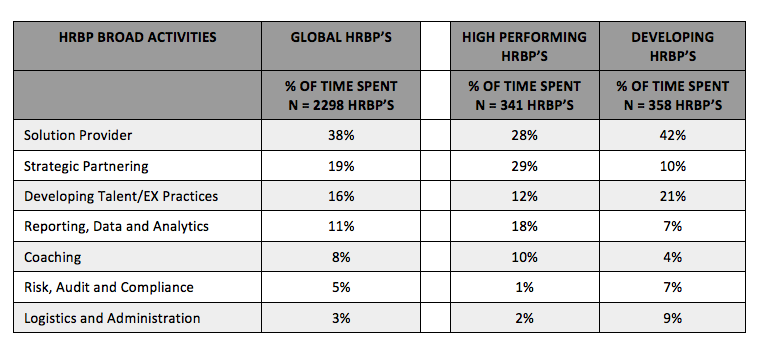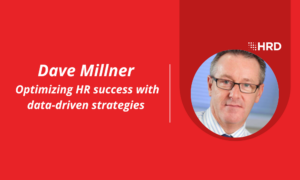Strategic HR of tomorrow: Leveraging data and analytics for success
- 5 Min Read
Dave Millner outlines why the HR business partner must become an even more crucial touch point for business leaders than ever before.
- Author: Dave Millner
- Date published: Jan 26, 2023
- Categories

It’s been over 25 years since the concept of the HR Business Partner (HRBP) was developed by Dave Ulrich. There have been some challenges in adopting and evolving the role, but recent disruptions have reiterated the need for HR to get closer to the ever-changing business strategies that drive increasingly demanding expectations of the workforce.
These challenges can relate to hybrid strategies through to the development of new ways of working in an ever-increasingly automated work environment. Whatever the challenge the HR function must be closer to the business leaders and credibly deal with the wide-ranging issues that require support and resolution in an impactful and appropriate way.
The HRBP- an even more crucial touch point for business leaders
The HRBP must become an even more crucial touchpoint for business leaders than ever before. That means dealing with an ever-increasing need to demonstrate value and commercial insight and ensuring that the largely tactical, administrative function of the past becomes the strategic ‘added value’ function that focuses on resolving priority business problems and building the capabilities of the workforce so that they can deliver and support the achievement of the business’s strategies.
There has been a lot of talk about the HRBP being a data and analytics translator. That is a conduit between data scientists/people analytics specialists and executive/senior leader decision-makers. They are adept at understanding the business needs of an organization and are data savvy enough to be able to distill trends, patterns, and insights in an easy-to-understand manner. It certainly makes sense as they ‘own’ the relationship with senior leaders, but do they have the capability and capacity to do that?
A data-driven approach
For the period 2020 until the end of 2022, a wide range of HR workshops (mostly virtual) have been facilitated by me across the globe, focusing on helping and supporting HR practitioners, mainly HRBPs, to become more strategic and data-driven in their approach. As a part of those workshops, a simple self-reported job analysis framework was used to identify how the HRBP’s use their time. It focused on:
- the activities they focused on;
- the time spent on those activities;
- their current level of performance in their role.
2,298 HRBPs shared their feedback over this period based upon seven key themes, that built upon similar research that was undertaken by the Talent Strategy Group regarding HRBP’s in 2019:
- Solution provider (resolving local operational puzzles)
- Strategic partnering (focusing on strategic people interventions and future-based initiatives)
- Develop talent/employee experience practices (resolution and improvement of talent-based practices)
- Reporting, data & analytics (focusing on data-based reporting and supporting the scoping of and execution of people/HR analytics-based projects)
- Coaching (supporting leaders and managers to learn and resolve how to address people-based issues)
- Risk, audit & compliance (fulfillment of governance-based demands)
- Logistics and administration
The table below summarises the self-reported results in terms of focus and time spent; average working week for an HRBP is c50 hours.

Key findings and further differences
The key findings revolve around:
- HRBPs remain focused on resolving operational challenges (38% of their time); ‘operational puzzles’ as I refer to them. It raises some key questions that need to be considered:
- Is this because the HRBP is operating in their comfort zone?
- Alternatively, are HRBPs becoming involved too easily in these challenges? If leaders and managers are truly line/people managers, as has been talked about for some time now, should they not be operating without high levels of HRBP support in this operational area?
- Are HRBPs prioritizing sufficiently to ensure that their time and resources are being used efficiently?
- This has a knock-on effect upon HRBPs ability to focus on more strategic activity (for example, alignment of key HR practices and projects to support the achievement of crucial business objectives) and find quality time to focus on data, analytics-based activity and insights or work with experts who have that numerical expertise.
Additionally, comparison between the self-reported 341 high-performing HRBP’s, and those who reported themselves as having development needs, 358 HRBP’s, highlighted further differences:
- High-performing HRBP’s spend less time and focus on operational puzzles (28%) versus the developmental HRBP’s who spend 42%;
- High performing HRBP’s spend 29% of their time on strategic interventions, future-based challenges and people planning, versus the developmental HRBPs who spend 10% of their time in this area;
- High-performing HRBP’s spend less time focusing on the efficiency and improvement of local talent practices, 12% versus 21% for the developmental HRBPs;
- Finally, high-performing HRBP’s spend more time, 18% focusing on reporting, data and analytics-based activity (for example, the analysis of reports, scoping and support of people analytics activity, storytelling, etc.) whereas the developmental HRBPs spend 7%.
A focus on what adds value
The HRBP role is a complex and ‘in demand’ role. Dave Ulrich has regularly reinforced the need for the HR/people function to focus on accelerating business results by ensuring that HR provides relevant data and information that guides and prioritizes people-based investments to make sure that they deliver the greatest impact on stakeholder outcomes. This is where the overlap between data, analytics and being more strategic occurs; HRBP’s need to find ways to focus on what adds the greatest value to the organization through the portfolio of HR practices. It starts with us being far more critical about how we spend our time; we can’t learn without having the scope and time to do this.
All behavioral change is not the same. Some changes are simple, direct, and easy to understand but data and people analytics is not, and complex change is as much about the heart as it is the mind. The opportunity to learn and develop your data-based analytics expertise is vital to the future of the function and HRBP’s need to make time to take their own learning seriously; if nothing else you need to significantly improve your data literacy as the leading people analytics organizations ensure that this becomes a reality.


